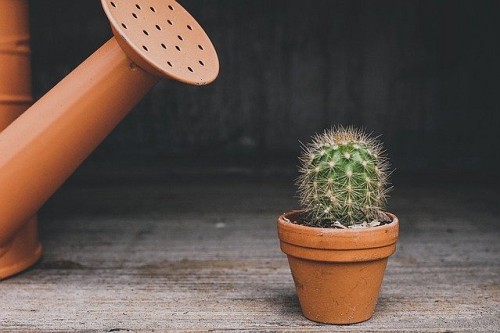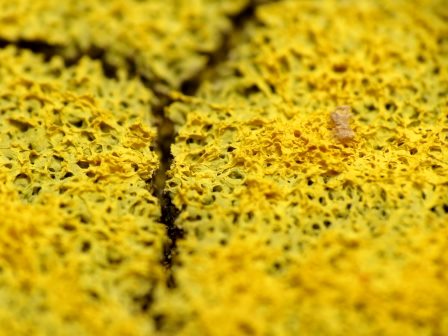Dog Vomit Slime Is GOOD: A Lighthearted Look At Houseplant Care
 Eew! What’s that? As the proud houseplant care giver to 22 beautiful specimens, I’d never seen anything like it before. A science fiction-ish yellow slime adorned the soil of one of my indoor plants.
Eew! What’s that? As the proud houseplant care giver to 22 beautiful specimens, I’d never seen anything like it before. A science fiction-ish yellow slime adorned the soil of one of my indoor plants.
Before scooping it out, dumping my potting mix, and starting afresh, I looked up the phenomenon on Google... and found the goo was harmless, even healthy. Which made me realize that it’s high time for me to go back to gardener school, as it were, and review Houseplant Care 101.
- Don’t scoop that slime! Is it mold? Is it fungus? Did your pooch just throw up in the aspidistra? Dog vomit slime is a pale yellow to orange goo that appears in plant pots or in huge swaths all over your yard. This mold looks as gross as it sounds, but is, in fact, beneficial to your potting soil, breaking down woody matter. Really want to get rid of it? Reduce the amount of watering in your houseplant care routine.

- A little water goes a long way. More houseplants are harmed by overwatering – which suffocates their roots -- than underwatering. Gently poke your finger into the soil; if the top inch or so is dry, it’s time to water. Use a watering can with a long, narrow spout so you don’t splash the leaves. Many houseplants hate that and some (like African violets) can become permanently water stained.

- Stale water rules. The tap water found in most municipalities will be fine for your potted plants... but let it stand for 24 hours before watering. During this waiting period, most of the tap water’s fluoride and chlorine will dissipate, making it safer for the plants. ANOTHER BENEFIT: H2O that’s been allowed to come to room temperature won’t shock their root systems.

- Sometimes you have to be cruel to be kind. Cutting back certain houseplants – geraniums, I’m looking at you -- helps their health. They’ll be greener, stronger, and shapelier after a good hard prune. Best time is fall, once flowering species are finished blooming, and again in spring, a week before pots go outside for the summer. And make pinching off dead leaves and spent blossoms part of your regular houseplant care.

- Most houseplants are happy tiny house dwellers. Plants tend to need a smaller space than we think and indeed, enjoy being a bit rootbound. How do you know you finally need to repot? When your indoor plants are more than 3 times as large as their pot, break the sides of their container, or start growing roots out the drainage hole on the base. March and early April are ideal months for repotting.

- Rethink “not in my backyard.” Invasive species like bamboo or English ivy are undesirables in your outdoor garden, true. However, the same backyard bully qualities that lead them to take over your yard (and possibly your neighbors’ too) make these foolproof as indoor plants, even for the most brown-thumbed gardener. They’re low-maintenance and hard to kill, yet very attractive. Just keep them confined to a pot.

- Houseplants make great gifts -- clothing optional. Want a charming, inexpensive gift idea? Give your family and friends indoor plants. You could buy them, but it’s more fun (cheaper, as well) to give your own cuttings. Aloe vera and spider plants are 2 species that produce “babies” you can simply snip off, pop in a container of potting soil, attach a note on houseplant care... and dress in adorable teeny outfits if that’s your thing.

- Take care of your aloe vera and it will take care of you. A personal favorite is aloe vera; it’s easy to grow and propagate ... and it loves you back! Aloe vera houseplant care involves simply keeping it in a bright spot out of direct sun, between 55 and 80 degrees, and watering every 3 weeks (less often in winter). In return your aloe will provide you with a marvelous gel to treat dry skin, burns, insect bites, and more. Just break open a leaf.

- Bring spring into your home early. Nothing shouts “Spring!” like a bunch of blossoms. Get a headstart by forcing hyacinth or narcissus bulbs. No need for soil. Just place root-side-down on a bed of pebbles in a clear glass container. Add water to cover the bottom quarter of the bulbs and top up every few days.
HOUSEPLANT CARE TIP: If your posies flop, give them a shot of vodka. Unlike its effect on humans, the beverage will encourage them to stand up straight.
- Indoor plants deserve a vacation. Most houseplants are thrilled to spend the warm months sunning on a patio, porch, or balcony. But your local landscaping pro will advise, “Don’t shock their system – acclimate gradually to the new conditions.” Proper houseplant care means setting plants in a shady, sheltered outdoor spot for a few hours daily when nighttime temperatures rise above 50 degrees. Increase sun exposure gradually.
Laura Firszt writes for networx.com.
Looking for a Pro? Call us (866) 441-6648

Landscaping Average Costs
Landscapers Experiences

Leaf Removal This Year, More Landscape Work Next Summer

The Right Landscaper Can Change A Yard From Terrible To Terrific

Successful Removal Of A Very Large Tree
Top Cities Covered by our Landscapers
Austin
| Boston
| Charlotte
| Chicago
| Columbus
| Dallas
| Denver
| Detroit
| El Paso
| Fort Worth
| Houston
| Indianapolis
| Jacksonville
| Los Angeles
| Memphis
| Nashville
| New York
| Philadelphia
| Phoenix
| Portland
| San Antonio
| San Diego
| San Francisco
| San Jose
| Seattle
| Washington



